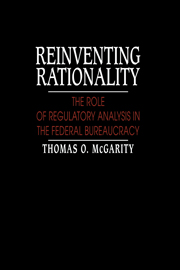Book contents
- Frontmatter
- Contents
- Acknowledgments
- Abbreviations
- Introduction
- Part I The clash of regulatory cultures
- Part II Regulatory analysis in theory and practice
- 3 Getting the lead out of gasoline: EPA's lead phasedown regulations
- 4 Getting the dust out of the air: EPA's ambient air quality standard for particulate matter
- 5 Getting obstructions out of the driver's view: NHTSA's field of direct view regulations
- 6 Getting the bone out of processed meat: FSIS's mechanically separated meat standard
- 7 Getting information into hazardous workplaces: OSHA's hazard identification regulations
- 8 The virtues of regulatory analysis
- 9 Limitations of regulatory analysis
- 10 Regulatory analysis in the real world
- Part III Structuring regulatory analysis into the decisionmaking process
- Part IV Review of regulatory analysis
- Part V Conclusions
- Notes
- Bibliography
- Index
5 - Getting obstructions out of the driver's view: NHTSA's field of direct view regulations
Published online by Cambridge University Press: 16 October 2009
- Frontmatter
- Contents
- Acknowledgments
- Abbreviations
- Introduction
- Part I The clash of regulatory cultures
- Part II Regulatory analysis in theory and practice
- 3 Getting the lead out of gasoline: EPA's lead phasedown regulations
- 4 Getting the dust out of the air: EPA's ambient air quality standard for particulate matter
- 5 Getting obstructions out of the driver's view: NHTSA's field of direct view regulations
- 6 Getting the bone out of processed meat: FSIS's mechanically separated meat standard
- 7 Getting information into hazardous workplaces: OSHA's hazard identification regulations
- 8 The virtues of regulatory analysis
- 9 Limitations of regulatory analysis
- 10 Regulatory analysis in the real world
- Part III Structuring regulatory analysis into the decisionmaking process
- Part IV Review of regulatory analysis
- Part V Conclusions
- Notes
- Bibliography
- Index
Summary
The National Highway Traffic Safety Administration (NHTSA) was created in the mid-1960s after Ralph Nader convinced the nation that traffic safety depended as much upon the “nut on the wheel” as the “nut behind the wheel.” Although state highway safety agencies are responsible for ensuring visual acuity for the human half of the man-machine combination, NHTSA must ensure that the machine half does not unnecessarily obstruct the driver's view of the road and of approaching hazards. The long-studied, but never implemented “Field of Direct View” (FDV) standard was NHTSA's attempt to establish requirements for a minimum field of view for the driver, for light transmittance through windshields, and for the permissible size of obstructions (e.g. roof pillars and rear-view mirrors) in the driver's field of view.
Regulatory background
Shortly after its creation, a NHTSA contractor reported that automobile rear-view mirrors were a major obstruction to driver vision and that roof pillars in both the front and the rear of some automobiles created substantial “blind spots.” The agency also became concerned that windshield tinting could cause night visibility problems. The agency in April 1972 proposed a standard that would set requirements for: (1) obstructions in the driver's fields of view; (2) light transmittance levels of windshields; (3) visibility of the vehicle's corners; (4) visibility of ground surface targets for trucks, buses, and other such passenger vehicles; and (5) view obstruction by sun visors.
Comments on the proposal were “strong, critical and helpful.” Manufacturers agreed “in principle” with some of the proposals, but they disagreed with the agency and among themselves as to how visibility requirements should be achieved.
- Type
- Chapter
- Information
- Reinventing RationalityThe Role of Regulatory Analysis in the Federal Bureaucracy, pp. 62 - 72Publisher: Cambridge University PressPrint publication year: 1991



